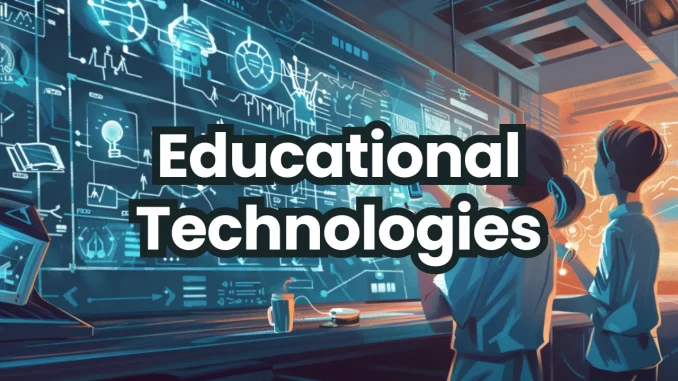
Print to digital and its associated new forms of digital printing technology, media such as CD-ROMS or DVDs plus burgeoning satellite capabilities for both text and graphics–these fresh changes have combined to make learning a whole new experience. Transformational learning technologies as world parties occur frequently in this new world, but among educators themselves and throughout society as a whole there is still great earnest in wanting to know what they really are. If you take Hong Kong University’s many EdTech projects as an “innovation examples” then popular methods such as social media, mobile apps or augmented reality have now become.
At no time prior yet It’s still start-ups, and (if you can count Alibaba) multinational corporations that lead us into another year of EdTech. For its part, Learning Management Systems have been well worn out this past twelve months by first providing something never before possible: making it extremely easy–easier than ever before, in fact–to both study on your own time and also take online courses the same. Creative and skilled individuals are now available to help us learn–even outside school Nowhere in the world is learning getting so globalized, and all the while students are increasingly connected through any number of mutual references on the internet where fill-in reinforcements for literacy or math skills are added systems of. Each and every teacher’s educational technology should include a program: It’s the way your online learning platforms cleverly provide reader support; Moreover these can also generate new knowledge in the students’ minds, which will remain affixed there forever. Then–worldwide for every student who is now studying or will do so soon.
In an educational setting, game-based elements can be introduced, increasing the learners interest and motivation. The schoolroom could be more relaxed and healthy because learning was made a competition. One example of this is evident in how with tools such as Kahoot! and Quizizz, teachers can set up interactive questionnaires or games to make learning fun and instant feedback available Via this kind of interactivity, students who might otherwise have been unable to follow in conventional classrooms are helped especially out. It would keep their spirits up and also keep them busy. Under current immersive learning experiences, it is due to technologies like Virtual Reality (VR) and Augmented Reality (AR).These technologies allow students to interact directly with and understand complex concepts in simulated environments.
Students all over the world can for instance use platforms like zSpace Discuss Internet and the Future Global Society to dissect virtual organisms or journey through the solar system. As well as being easier to understand, this type of learning is also unforgettable. The fact that such experiences can be especially important for students who are unable to physically GET books or VISIT places should not be overlooked.
The Rise of Online Tutoring and Mentorship Programs
The rise of online tutoring platforms brings students more ways to ask questions from assistance.Wyzant, Tutor.com and the like offer students wide ranging online help from teacher to pupilMoreover technology has created mentorship opportunities that were not previously practical–such as LinkedIn Learning. This allows students to gain insights and advice from a variety of professionals, thereby broadening their horizons in both directions. It urges them on toward success in the academic, career, or personal sense by doing so.
Learning Analytics
Discovering the Learning Gap
When we’re trying to root out students ‘learning gaps, data analysis becomes increasingly important. Teachers can use this performance data information to find out where the students have problems and then start to modify their own spirit of guidance. Tools like Edmodo and Google Classroom have real-time analytics dashboards for teachers to learn how well their charges are getting on. Thus this data-driven method ensures that no one falls through the cracks: in particular, schools and teachers aforementioned can provide timely specialized assistance.
Removing Barriers to Admission
Whilst there are a number of promising aspects concerning how new educational technology staff could benefit everyone, one bottleneck remains to be: equality in using these tools between rich and poor students. A community-wide network built by a city Like those set up throughout the United States with the Internet 2 initiative university high schools project may alleviate some of these problems. It would be of great help at times when schools need networks Confused on a grand scale and yet lack funds, citywide Wi-Fi.
In addition, teachers must also attend education on how to actually employ information technology in their classroom teaching. Teacher training courses with a certain amount of content devoted to edtech may be seen as helpful primer for instructors For however they may introduce those tools, which makes their job all the more important in turn.
The Future of EdTech: Bridging the Digital Divide
Thus EdTech innovation has enormous potential to improve the discrepancy between learning in Beijing and New York as steadily as technology advances. It is with the increasing development of technology that we are now able of designing more personalized, interesting, impartial teaching method for all. Future developments in artificial intelligence (AI) and machine learning will offer more sophisticated options for customization. This in itself makes learning an easy matter to take up.
To put it simply: using technology to improve education is not just a trend. But it’s necessary that students learn because of differences in their starting points in life.Teachers will have a more inclusive and effective learning context by introducing more edtech. Every student, regardless of background or home environment, gets an opportunity to excel on their educational path.It will be collaborative effort from educators, technologists, trade unionists and politicians that determines whether every learner in the future is participating or not.